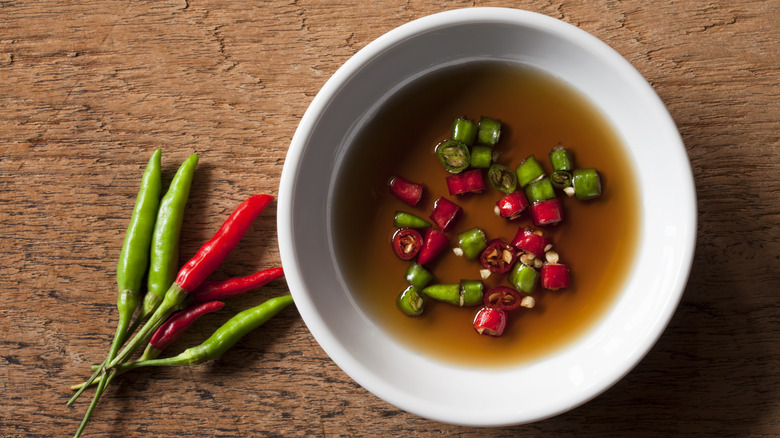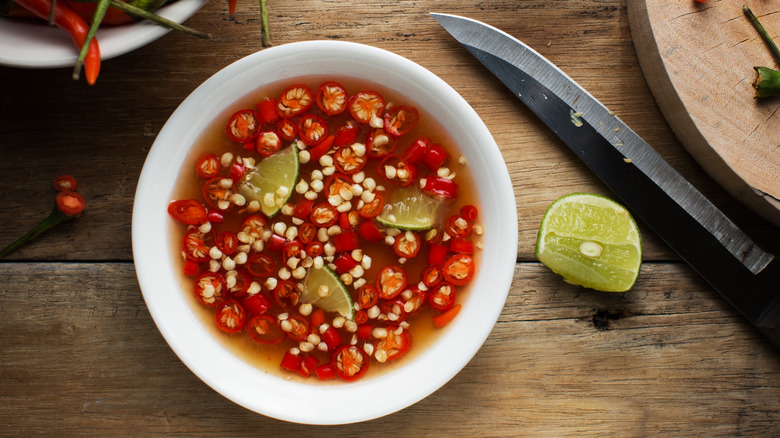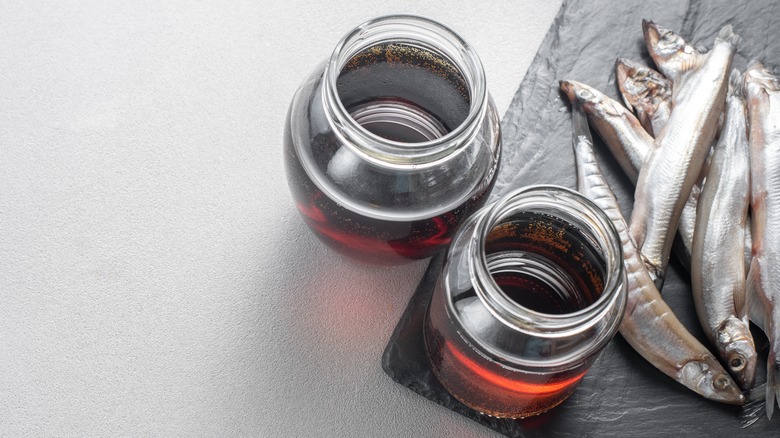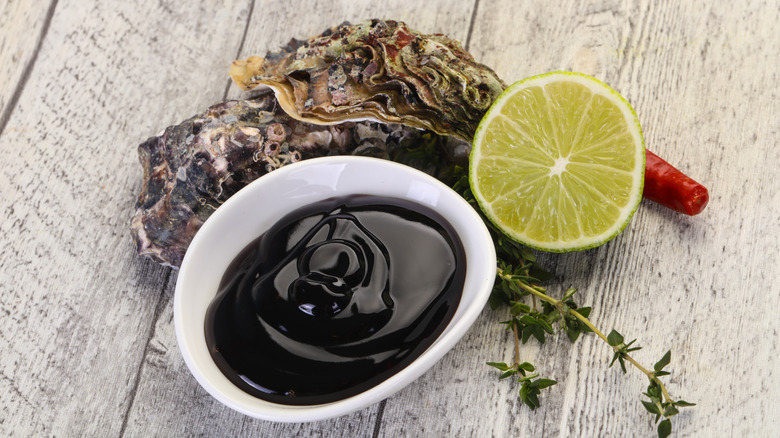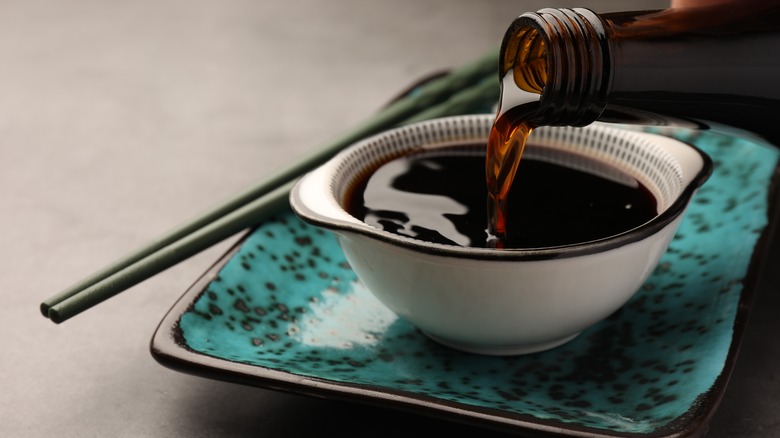What Is Fish Sauce And How Do You Cook With It?
Soy sauce and oyster sauce might have their claims to fame across a range of cuisines (especially among East Asian and Southeast Asian cultures), but equally popular is their even more potent cousin — fish sauce. While the name may not ring as many bells, if you've ever chowed down on fried rice or enjoyed a nice, steaming bowl of pho, chances are you've consumed fish sauce already.
You can continue to happily do so by learning more about this versatile condiment, which has been used in a variety of dishes for centuries. At home, fish sauce is easy to incorporate into your meals due to how inexpensive and readily accessible it is. It's made of only a few ingredients, and you can always pick it up at your local grocery store in time to spice up your next meal. On top of all that, fish sauce is easy to store for future use.
What is fish sauce?
You're likely to associate a bottle of fish sauce with your local ramen restaurant these days, but the condiment actually dates back to the seventh century B.C., when it was first used by the ancient Greeks along the Black Sea. Known to them as gàros, this reddish-brown, runny liquid was made using a similar process to what is used today.
This highly versatile sauce calls for only three simple ingredients: an oil-rich fish (often anchovies, shrimp, or krill), salt, and water. This mash is then left in barrels to ferment for up to two years, allowing enough time for nature to take its course and break down the fish, leaving behind a liquid that can be strained or pressed out.
The result is the staple ingredient you can now find most commonly used in Asian cuisines, like those of Vietnam, the Philippines, Thailand, and China. Fish sauce is a flavorful element that can truly spruce up a dish, whether it's the dipping sauce of your Filipino lumpia or added to a panang curry tomato bisque.
What does fish sauce taste like?
Fish sauce didn't get its name from nothing. With the limited number of ingredients used to make it, the condiment tastes exactly as expected — fishy (not too shocking, right?). Its strong, powerful flavor is accompanied by an equally pungent smell. Not surprisingly, fish sauce has a strong kick to it when used as a stand-alone ingredient. It's not hard to immediately sense this salty, sometimes overwhelming quality, which is why it's recommended to use fish sauce sparingly and as needed. The intense taste can be lessened by adding water to the fish sauce or carefully selecting the brand you use. For example, Thai fish sauce, like the brand Tiparos, is known to be saltier than Vietnamese fish sauce, like the brand Red Boat.
Regardless of which brand you choose, when the sauce is heated and combined with other ingredients in a marinade or dressing, its fishy taste diminishes and instead provides dishes with a savory, umami flavor. It adds just the right tang, pairing well with noodles, soups, vegetables, seafood, meat, and much more. Fish sauce can even be utilized in sweeter dishes. It may be a bit out of your comfort zone, but it's not unheard of to add fish sauce to caramel or peanut butter in cookies, ice cream, and other dessert recipes to create a more balanced spread.
Nutritional information for fish sauce
Given its deep flavor, not much fish sauce is needed to change the way your next meal tastes, and with its insignificant amount of vitamins and minerals, the low-calorie condiment doesn't provide much nutritional value. Within a tablespoon serving of Red Boat fish sauce, for example, there are a measly 4 grams of protein and no carbohydrates. There is, however, a moderate amount of potassium, coming in at 105 milligrams. Potassium is key in maintaining the healthy function of your heart muscles and nerves, as well as moderating blood pressure.
What fish sauce lacks in nutrients, it overcompensates for with its high sodium content. Having been made with large amounts of salt, there are 1,430 milligrams of sodium per serving, which is already much of the 2,300-milligram recommended upper limit for daily salt intake. Fish sauces labeled as "low sodium" or "light" can help reduce this number.
The arrival of fish sauce in Asian cultures
With the origins of fish sauce tracing back to ancient Greece, early use of the condiment is just as commonly associated with the Roman version, known as garum. This product was the second most expensive liquid around, as it was believed to contain healing properties. It was a staple ingredient in the Roman diet, just as it is in many Asian cultures today.
Many countries' versions of fish sauce share similarities with garum. Vietnam's nuoc mam is especially notable for its comparable taste and texture, resulting from the two condiments being created using the same fermentation process. Food historian Giorgio Franchetti tells the South China Morning Post that nuoc mam is seen as a "'living archaeological culinary finding' that maintains the ancient Roman tradition and flavor."
This has led to conflicting beliefs as to whether or not fish sauce was introduced to Asian cultures through Greek and Roman influences. There is insufficient evidence connecting the Greco-Roman condiment with that of Vietnam or the Philippines, Thailand, or other Asian versions, though. The lack of evidence suggests that the varying versions were created independently from one another, underscoring the versatility of fish sauce and how a range of cultures can enjoy it.
Varieties of fish sauce
Given that fish sauce is associated with both Greco-Roman origins and Asian cuisines, various countries have their own version. As mentioned, Vietnam's nuoc mam is a particularly iconic and widely available choice. Phu Quoc, the Vietnamese island located in the Gulf of Thailand, has abundant anchovies and just the right heat and humidity to create the perfect fish sauce. As such, Vietnamese varieties of fish sauce have become known as higher-quality options among the available brands.
An equally accessible fish sauce is Thailand's nam pla. Sold under brand names like Golden Boy and MegaChef, nam pla is also made mainly from anchovies and is popular due to the similarly warm, sunny temperature it was created in. What sets it apart from its Vietnamese parallel is its saltier taste. Needless to say, this brininess is perfect for Thai cuisine, such as the famous prik nam pla, a traditional tableside condiment combining fish sauce, chilies, garlic, and lime that can be added to any finished dish.
Also skewing on the saltier, heavier side is patis. This Filipino variation of fish sauce is a by-product of the equally important mainstay bagoong. Bagoong is made from either partially or fully fermented fish, krill, or shrimp paste mixed with salt. During the same process in which bagoong is made, liquid is extracted to create patis. Lorins, Rufina, and Datu Puti are examples of Filipino brands to try out.
These Southeast Asian countries' takes on fish sauce are only a fraction of the varieties. Many other nations use fish sauce, from Cambodia's tuk-trey to Malaysia's budu, in a similar fashion.
How to cook with fish sauce
If it hasn't been emphasized enough, fish sauce is a funky ingredient that packs a sharp punch when used on its own. But when thrown into a preparation that calls for other ingredients, fish sauce elicits a distinct, complex taste that can completely elevate a dish. That's not to say you should dump an entire bottle into your next bowl of soup, though.
The key to cooking with fish sauce is using it in increments. Slow and steady wins the race with this condiment; add a few drops of it to your recipe at a time and gradually increase as needed. A little bit goes a long way, as it doesn't take much of this product to alter how your food turns out. This is largely due to how sodium-dense fish sauce is. Minimal amounts of both fish sauce and salt need to be used in one dish, and fish sauce can substitute salt altogether in some cases.
Once you've played around with it and gained a sense of how much fish sauce to use, it becomes easier to employ it as a flavor enhancer for a wide spread of cuisines. The condiment works well when used in pasta and meat sauces, dressings, marinades, soups, dips, stir-fries, sweet treats, and even cocktails. Just a few common recipes that fish sauce can really amp up include an irresistibly savory fried rice and even the timeless Caesar salad.
Where to buy fish sauce
Finding fish sauce in your local grocery store is even easier than spotting fish in the sea. The ingredient can be bought at most popular food retailers. It's typically among other condiments, sauces, and marinades or found in aisles designated for ethnic or international food. Available brands vary depending on what store you plan to purchase your fish sauce from, but you're guaranteed to find at least one option at your local Target, Walmart, and ShopRite.
To find the most varied assortment of fish sauces, though, make a trip to an Asian food market. In terms of brands, you're likely to find Red Boat, Lucky, Three Crabs, Squid Brand, and more. There will also be a wider range of choices between low-quality and high-quality sauces, meaning you can be pickier with the product's cost. Prices for these fish sauces may range anywhere from about $2 to $30. If an Asian food market isn't available to you, Amazon offers numerous options for the condiment, too.
How to choose fish sauce
The taste and quality of fish sauce is contingent on a range of factors, including the country it's coming from, the type of fish used to make it, additives, and conditions during fermentation. All these components affect just how sweet or salty, subtle or potent, and high or low in protein the condiment will be. What bottle you should grab off the shelf ultimately comes down to the type of dish you're making and the flavor profile you're trying to achieve.
Although there's a recipe for every type of fish sauce to shine as the most suitable option, Vietnamese fish sauce is considered top tier by many, with the most renowned fish sauces coming from the island of Phu Quoc. Exports from this region tend to have higher nitrogen content, an indicator of more protein and a deeper umami flavor. In fact, fish sauce is often graded by its nitrogen content.
These grades, measured in degrees, are found on the bottles' labels. If a fish sauce is 30°N or above, it's seen as high-grade. Because higher-grade fish sauces emanate a richer taste, it's best to use them in ways that bring out the potential of their flavor, such as in a dip or dressing. Otherwise, fish sauces with lower nitrogen levels will do just fine for recipes where the protein is cooked down and mixed with other ingredients.
How to store fish sauce
If you aren't emptying bottle after bottle of fish sauce in your daily cooking, an opened container of this dressing can last up to three years if stored properly. The large amount of salt makes it harder for bacteria to thrive. This doesn't mean fish sauce can't go bad, though.
Higher nitrogen levels in fish sauce might signify more protein and bigger flavor, but they also increase the chances of gas buildup. Warm temperatures provide a suitable environment for gas to accumulate, and these gasses will seep out of the bottle once it's opened, releasing an even more pungent smell than the sauce once had. For this reason, it's best to keep your fish sauce bottle tightly sealed in the refrigerator. Though refrigeration isn't necessary or required, the fridge is where the product's quality will be best maintained and its shelf life may be extended.
If that option isn't available, fish sauce bottles should at least be kept in a cool, dark place. This will reduce the chance of the sauce not only of forming gas and an even more potent scent but also becoming darker and more intense in flavor, which can happen if it's not stored in a suitable place.
Fish sauce vs. oyster sauce
For those who may not enjoy the acquired taste fish sauce brings, oyster sauce can be used as a substitute. Also produced from seafood and commonly used in Asian dishes, oyster sauce was first made by accident by Lee Kum Sheung in 1888. Sheung, the founder of Lee Kum Kee, a food company in Hong Kong that manufactures authentic sauces, was cooking oysters in his teahouse. When he forgot to put out the stove's fire, what resulted was the dark brown paste that's now often used in stir-fry recipes and marinades. Taking inspiration from Sheung's serendipity, today's sauce is made by taking the liquid that's left behind after oysters are boiled and adding salt, sugar, and cornstarch.
Both oyster sauce and fish sauce bring savory notes to meals, but switching one for the other can make a big difference in a recipe's outcome. Because cornstarch and sugar are added to oyster sauce, the condiment is much thicker and sweeter than the runny, tangy liquid that is fish sauce. Fish sauce not only induces a fishier taste than oyster sauce but also a much fishier scent. Oyster sauce is bolder and deeper in color, giving off a dark black-brown hue versus fish sauce, which tends to be transparent with a tint of red-brown. Despite their varying depths and textures, though, both condiments will still bring an umami taste to your dish.
Fish sauce substitutes
Fish sauce might not be everyone's cup of tea, but there's no objecting to a full-flavored, piquant meal. Luckily, whether you're vegan, allergic to seafood, or simply like having choices, there are substitutes to fish sauce that can help you achieve that similar zest you might be looking for.
Also coming from fermented ingredients and high in salt, soy sauce is a comparable alternative to fish sauce. It's just as thin and runny, allowing you to use it in a one-to-one ratio. There are different variations of soy sauce you can choose from to best suit your cooking needs. Light soy sauce, for instance, is a bit thinner and saltier. Dark soy sauce, on the other hand, is thicker and often used for the aesthetic purpose of adding color to your food. Adding to the list of fermented substitutes is Worcestershire sauce. It leans into the same notes fish sauce does, tasting sweet and salty all at once.
Several types of seaweed, such as wakame, nori, and kombu, can serve as fish sauce replacements. And because it comes from the ocean, seaweed naturally has salt content to emulate the briny taste of fish sauce, albeit to a lesser extent. If you're looking for a less salty path to take, coconut aminos is a great choice. Coming from fermented coconut palm sap, this dark brown sauce is soy-, fat-, and gluten-free. Other popular fish sauce substitutes include tamari, miso paste, and dried shiitake mushrooms.
